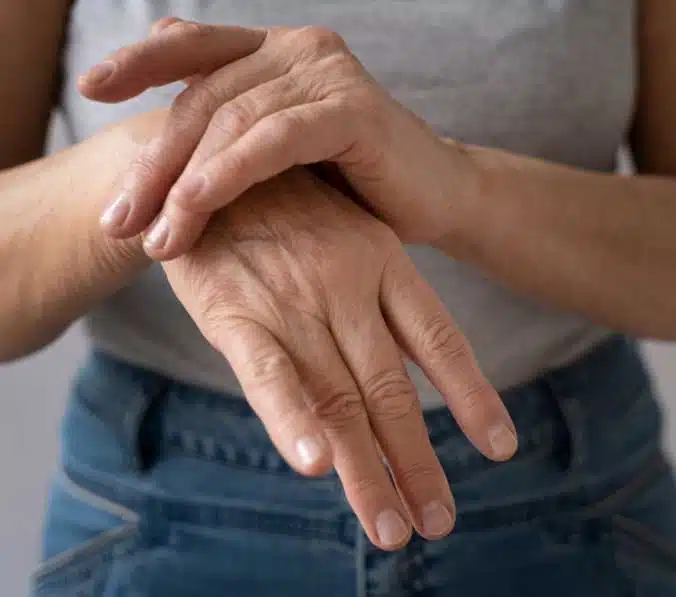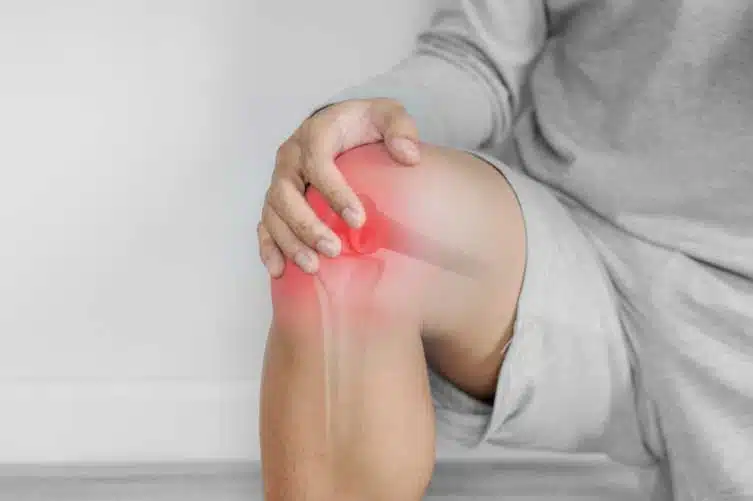Rheumatoid Arthritis Specialist In Elmhurst IL
Are you experiencing stiffness, pain, and swelling in your joints that just won't go away? You may be living with rheumatoid
arthritis, a chronic autoimmune disorder that can make even the simplest tasks impossible. As orthopedic specialists, we
understand the frustration and limitations of this condition and are here to help. With our cutting-edge treatments, personalized
care, and experienced specialists, we can help you take control of your symptoms and improve your quality of life. But first, let’s
discuss the symptoms, diagnosis, treatments & other things related to RA.
What Is Rheumatoid
Arthritis (RA)?

Rheumatoid arthritis (RA) is a chronic autoimmune disorder that primarily
affects the joints. The immune system, which normally fights off infections,
mistakenly attacks the lining of the joints, causing inflammation that leads to
pain, stiffness, and swelling. Over time, the inflammation can damage the
cartilage and bone in the joint, leading to joint deformity and disability. RA can
also affect other body parts, including the lungs, heart, and eyes.
While there is no cure for RA, treatments such as medication, physical
therapy, and lifestyle changes can help manage symptoms and slow down the
progression of the disease. Early diagnosis and treatment are important to
prevent joint damage and improve quality of life.
What Happens In
Rheumatoid Arthritis?
RA occurs when the immune system mistakenly attacks the synovium, a thin layer of tissue that lines the joints. When the synovium becomes inflamed, it produces excess fluid, leading to swelling and pain. Over time, the inflammation can damage the cartilage and bone within the joint, leading to deformity and disability.
Affected Areas
RA can affect any joint in the body, but it often starts in the small joints of the hands and feet. As the
disease progresses, it can affect larger joints like the hips, knees, and shoulders. Some people with RA
also experience symptoms in other body parts, such as the eyes, skin, and lungs.
Risk Factors

While RA can affect people of any age, it usually develops in middle age (between 30 to 60 years old). Here are some factors that increase the risk of developing RA:
- Age: Older people are at higher risk of developing RA.
- Sex: Women are three times more likely to develop RA than men.
- Family history and genetics: Having a family member with RA increases the risk of developing the disease.
- Obesity: Being overweight or obese can increase the risk of developing RA.
- Smoking: People who smoke are at higher risk of developing RA, and the risk increases with the amount of tobacco and duration.
Symptoms
of Rheumatoid Arthritis

RA symptoms can vary from person to person and can come and go. Some people may have mild symptoms, while others may experience severe pain and disability. Some common symptoms of RA include:
- Joint pain, stiffness, and swelling
- Fatigue
- Fever
- Warmth and redness in the affected joints
- Loss of range of motion
- Joint deformity
- Numbness or tingling in the hands and feet
Complications of Rheumatoid Arthritis
Rheumatoid arthritis is a chronic inflammatory disorder that primarily affects the joints. Although it is known to cause joint pain, stiffness, and swelling, it can also lead to several other complications that can significantly affect a person’s quality of life which include:
- Joint deformity: As the disease progresses, it can cause damage to the cartilage and bone in the joints, leading to deformity and joint instability.
- Loss of function and disability: The inflammation in the joints can limit their mobility, making it difficult to perform basic tasks like walking, climbing stairs, or grasping objects.
- Reduced quality of life: The chronic pain and disability associated with the disease can lead to depression, anxiety, and social isolation. It can also affect a person’s ability to work, participate in hobbies and activities, or even perform household tasks.
- Infections: the disease can weaken the immune system, making it easier for infections to develop and more difficult for the body to fight infections. Respiratory, skin, and urinary tract infections are more common in people with rheumatoid arthritis.
- Lung problems: Chronic inflammation can cause lung scarring, leading to shortness of breath, coughing, and chest pain. This condition is called interstitial lung disease and can be life-threatening if left untreated.
- Heart problems: Chronic inflammation can lead to the development of atherosclerosis, a condition where plaque builds up in the arteries, increasing the risk of heart attack and stroke.
- Lymphoma: It is a type of cancer that affects the lymphatic system. Although the exact link between rheumatoid arthritis and lymphoma is not fully understood, chronic inflammation and immune system dysfunction may play a role.
What Causes
Rheumatoid Arthritis?
The exact cause of RA is unknown, but researchers believe a combination of genetic and environmental factors is involved. In people with RA, the immune system mistakes healthy cells in the synovium for foreign invaders and attacks them, leading to inflammation and joint damage. Factors that may trigger this abnormal immune response include infections, hormones, and environmental factors like smoking.
Diagnosis of
Rheumatoid Arthritis
If left untreated, RA can cause severe joint damage and disability. Therefore, early diagnosis and treatment are critical in managing the condition. Doctors diagnose RA by
- Medical History During the medical history evaluation, the doctor will ask questions about your symptoms, family history, past medical problems, medications, and lifestyle. It is essential to give your doctor accurate and detailed information to help diagnose RA. Your doctor will try to identify any factors that could trigger the inflammation and distinguish RA from other types of arthritis.
- Physical Examination The doctor will assess your joints for swelling, pain, and stiffness during the physical examination. They will also look for other signs of inflammation, such as redness or warmth. The doctor will examine your joints’ range of motion and strength to determine the extent of the damage and the severity of your condition. The physical exam is crucial in diagnosing RA.
- Laboratory Test Lab tests are necessary to diagnose RA and monitor disease activity. The following are some common blood tests used to diagnose RA:
- Rheumatoid Factor (RF) – a protein the immune system produces during an infection or inflammation. High levels of RF often indicate RA.
- Anti-cyclic Citrullinated Peptide Antibody (ACPA) – a protein that the immune system produces when it attacks healthy cells in the body. High levels of ACPA are often found in people with RA.
- Complete Blood Count (CBC) – this test helps identify anemia common in people with RA.
- Erythrocyte Sedimentation Rate (ESR) – this test checks how quickly red blood cells settle in a test tube. High sedimentation rates often indicate inflammation.
- C-Reactive Protein (CRP) – this test measures the amount of protein produced in the liver during inflammation.
- Imaging Tests can help diagnose RA and monitor disease progression. The following are some of the common imaging tests used to diagnose RA:
- X-rays – this test can detect bone damage, including the erosion of joints and cartilage loss.
- Magnetic Resonance Imaging (MRI) – This test produces detailed images of the joints and can detect early signs of inflammation.
- Ultrasound – this test can detect inflammation in the joints, tendons, and other soft tissues.
- Other Tests – in some cases, your doctor might recommend a CT or PET scan to get a more detailed image of your joints.
Treatment of
Rheumatoid Arthritis
With the right treatment and lifestyle changes, it is possible to manage the disease effectively. Let’s discuss the various treatment options available for RA that can improve symptoms and quality of life.
- Medications
- Anti-Inflammatory Drugs: Anti-inflammatory drugs, such as non-steroidal anti-inflammatory drugs (NSAIDs), are commonly used as a first-line treatment for RA. They work by reducing pain and swelling in the joints. However, NSAIDs can have side effects like stomach ulcers and kidney damage, so they must be used cautiously.
- Corticosteroids: Corticosteroids are another class of medications that can be beneficial in managing RA symptoms, particularly joint pain. They can be ingested orally or injected directly into the affected joint. However, long-term use of corticosteroids can lead to side effects like weight gain, mood swings, and an increased risk of infections.
- Disease-Modifying Antirheumatic Drugs (DMARDs): DMARDs can help slow the progression of RA, reducing joint damage and preserving joint function. Methotrexate, sulfasalazine, and leflunomide are common DMARDs used to treat RA. They work by suppressing the immune system, but they can also have side effects like liver damage, so regular monitoring is necessary.
- Biologic Response Modifiers: Biologics are a type of medication that target specific parts of the immune system that contribute to inflammation. They can be effective in treating RA that is unresponsive to other treatments. However, biologics are expensive and can have side effects like increased risk of infections and allergic reactions.
- Lifestyle Therapies
- Physical Therapy: Physical therapy can be beneficial in managing RA symptoms. A physical therapist can suggest exercises to improve joint flexibility and strength and reduce pain and stiffness. They can also teach patients to perform daily activities without putting unnecessary stress on their joints.
- Occupational Therapy: Occupational therapy aims to improve daily activities like bathing, dressing, and cooking by suggesting modifications to the living environment to make it easier to manage. They can also suggest assistive devices like canes or splints to help with mobility.
- Surgery Surgery is generally reserved for patients with severe RA. Joint replacement surgery can help alleviate pain and improve joint function. Synovectomy, the removal of inflamed tissue lining joints, and tendon repair are other surgical options for RA.
- Routine Monitoring and Ongoing Care Regular monitoring is essential for managing RA. Blood tests can detect changes in disease activity, while X-rays can show joint damage over time. Routine check-ups with a doctor can also help identify and manage any medication side effects.
Why Choose
Orthopedic Specialists
If you're living with rheumatoid arthritis, you understand just how debilitating and life-altering this condition can be. At Orthopedic Specialists, we recognize the profound impact that rheumatoid arthritis can have on your physical and emotional wellbeing. That's why our team of expert specialists is highly trained in the diagnosis and treatment of this complex condition. Additionally, we offer precision joint replacement and reconstructive surgery designed to rebuild the delicate structures in the affected joints. With our compassionate approach, we listen to your concerns and work with you to keep you informed and involved in your treatment journey.
Book Your AppointmentFAQs
Rheumatoid arthritis is characterized by symptoms such as joint pain, stiffness, and swelling. Other common signs include fatigue, fever, loss of range of motion, joint deformity, and numbness or tingling in the hands and feet.
Treatment options for rheumatoid arthritis include a variety of medications, such as non-steroidal anti-inflammatory drugs (NSAIDs), corticosteroids, disease-modifying antirheumatic drugs (DMARDs), and biologic response modifiers. Lifestyle therapies, physical therapy, occupational therapy, and surgical interventions may also be recommended.
Risk factors for developing rheumatoid arthritis include age (older people are at higher risk), sex (women are three times more likely to develop RA than men), family history and genetics, obesity, and smoking.
Some individuals may explore alternative or complementary therapies such as acupuncture, herbal supplements, or mind-body practices like yoga or meditation. While these approaches may provide symptomatic relief for some individuals, it is important to consult with healthcare professionals before incorporating them into your treatment plan.
Maintaining a healthy weight, adopting an anti-inflammatory diet, engaging in regular physical activity, quitting smoking, and limiting alcohol consumption can all contribute to managing rheumatoid arthritis symptoms and improving overall well-being.
Yes, rheumatoid arthritis can affect other body parts, including the lungs, heart, and eyes. It is important to manage the condition comprehensively to minimize potential complications in these areas.